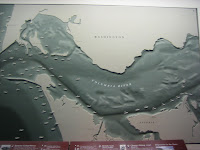 This is from an exhibit in the entry to the Columbia River Maritime Museum. It's a display of the number and locations of ships that wrecked entering or leaving the Columbia River. The Columbia begins far north of Oregon, in the Canadian Rockies, and travels south through Washington and eventually empties off the coast of Oregon into the Pacific ocean.
This is from an exhibit in the entry to the Columbia River Maritime Museum. It's a display of the number and locations of ships that wrecked entering or leaving the Columbia River. The Columbia begins far north of Oregon, in the Canadian Rockies, and travels south through Washington and eventually empties off the coast of Oregon into the Pacific ocean. The water, which has traveled for thousands of miles before it meets the sea, carries the considerable momentum it has gathered when it crashes headfirst into the waves of the ocean. It's this junction of the river and ocean waters that can create the treacherous waves -- some as high as 40 feet -- which have earned the Columbia the nickname of 'Graveyard of the Pacific.'
The water, which has traveled for thousands of miles before it meets the sea, carries the considerable momentum it has gathered when it crashes headfirst into the waves of the ocean. It's this junction of the river and ocean waters that can create the treacherous waves -- some as high as 40 feet -- which have earned the Columbia the nickname of 'Graveyard of the Pacific.' Any ship crossing the Columbia River bar must take on a bar pilot, a boat pilot who is responsible for bringing the boat across the waters safely so it can continue inland. Bar pilots will pull up to a freighter, for example, climb up a ladder along the side of the ship and replace the ship's pilot for the initial portion of it's voyage inland. The bar pilots are a very small, elite corps of Astoria boat pilots who have intimate knowledge of the tricky waters (and sands!) of the Columbia River; any ship trying to enter without a car pilot will be denied entry.
Any ship crossing the Columbia River bar must take on a bar pilot, a boat pilot who is responsible for bringing the boat across the waters safely so it can continue inland. Bar pilots will pull up to a freighter, for example, climb up a ladder along the side of the ship and replace the ship's pilot for the initial portion of it's voyage inland. The bar pilots are a very small, elite corps of Astoria boat pilots who have intimate knowledge of the tricky waters (and sands!) of the Columbia River; any ship trying to enter without a car pilot will be denied entry. For decades, Astoria was known as the Salmon Canning Capitol of the world. Millions of pounds of salmon were caught and processed here before being sent on to destinations throughout the US. The men who worked in canneries came from all over the world; the Chinese were here as early as the 1880's and the Scandinavians (mostly Finns, from what I understand) also settled here to fish.
For decades, Astoria was known as the Salmon Canning Capitol of the world. Millions of pounds of salmon were caught and processed here before being sent on to destinations throughout the US. The men who worked in canneries came from all over the world; the Chinese were here as early as the 1880's and the Scandinavians (mostly Finns, from what I understand) also settled here to fish. Semper Paratus
Semper ParatusThe museum also included a tribute to the United States Coast Guard, which has played a key role in Astoria's development as a port and ensuring the safety of ships entering and leaving US waters. The sheer volume of freighter traffic and fishing in the Columbia makes the question of potential disaster not an issue of 'if' but 'when.' The USCG maintains buoys, markers and lighthouses and performs rescues to crews and ships when they are in distress. With waters as busy as the ones off the coast, there aren't very many dull moments for the Coast Guard.
No comments:
Post a Comment